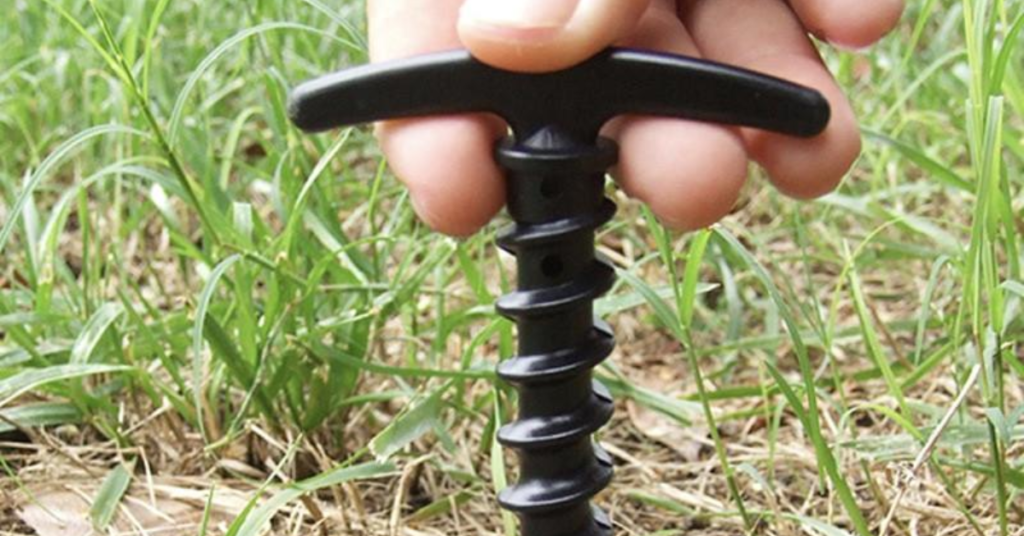Camping enthusiasts know that setting up a tent securely is one of the most crucial steps in having a successful outdoor experience. No one wants their tent to collapse in the middle of the night due to weak stakes or bad weather. This is where corkscrew tent stakes come into play, offering a stable, reliable, and easy-to-use solution for anchoring tents securely in a variety of terrains.
In this comprehensive guide, we’ll explore everything you need to know about corkscrew tent stakes: what they are, their benefits, how to use them, and why they are better than traditional stakes. We’ll also go over tips for choosing the right stakes for your needs and maintaining them properly for long-term use.
What Are Corkscrew Tent Stakes?
Corkscrew tent stakes are specially designed pegs with a spiral or helical shape, resembling a corkscrew. This design allows them to be screwed into the ground with greater ease and hold stronger in various types of soil, including soft, sandy, or loose ground where regular tent stakes may fail.
The corkscrew shape increases the surface area that is in contact with the ground, providing more grip and reducing the risk of the stakes pulling out under tension or when faced with high winds. These stakes typically have handles at the top, making them easy to twist into the ground without requiring tools or hammers.
Benefits of Corkscrew Tent Stakes
1. Superior Holding Power
Corkscrew tent stakes excel in stability, thanks to their unique design. The spiral shape allows them to dig deeper into the ground, creating more resistance than straight pegs. This makes them ideal for soft or loose soils, where regular stakes can easily become dislodged.
2. Versatile in Different Terrains
Whether you’re camping on soft sand at the beach, a muddy campsite, or grassy plains, corkscrew tent stakes offer excellent performance across all types of terrain. Their spiral design adapts to various surfaces, reducing the likelihood of the stakes pulling out even in extreme conditions like high winds or rain.
3. Easy Installation and Removal
One of the standout features of corkscrew stakes is how easy they are to install and remove. Unlike traditional stakes that require pounding into the ground with a hammer, corkscrew stakes can be twisted into the ground with minimal effort. This is especially useful in sensitive areas where pounding stakes might damage the surface or create noise disturbance.
4. Durable and Long-Lasting
Most corkscrew tent stakes are made of sturdy materials like steel or aluminum, which makes them highly durable. They can withstand rough conditions, including being twisted into rocky or compact ground. The corrosion-resistant properties of these materials also make corkscrew stakes suitable for long-term outdoor use, even in damp or humid environments.
5. Reduces Tripping Hazards
Since corkscrew tent stakes typically sit flush with the ground, there’s less chance of tripping over them compared to traditional stakes, which often stick out and can be a hazard around the campsite. The low-profile nature of corkscrew stakes makes them safer and more practical, especially for family camping trips.
Check Also: Innovations in Auto Insurance for Road Trips
How to Use Corkscrew Tent Stakes
Using corkscrew tent stakes is straightforward and doesn’t require specialized tools. Here’s a step-by-step guide to properly anchor your tent using these stakes:
1. Select the Right Spot
Choose a flat, stable area to set up your tent. While corkscrew tent stakes perform well on various terrains, it’s best to avoid areas with extremely rocky or uneven ground. Look for a spot where the stakes can be easily twisted into the soil.
2. Twist the Stakes into the Ground
Position the corkscrew stake at a slight angle towards the tent. This will provide better tension and resistance. Begin twisting the stake by hand, using the handle at the top of the stake. Apply steady pressure while turning the stake in a clockwise motion until it is firmly anchored in the ground. Most corkscrew tent stakes have a handle that allows for easy gripping.
3. Attach Tent Guy Lines
Once all stakes are securely twisted into the ground, attach the tent’s guy lines to the stakes. Ensure the lines are taut but not overly tight to prevent damage to the tent fabric.
4. Check and Adjust
After setting up, periodically check the stakes and guy lines, especially if the weather changes. If the wind picks up or it starts to rain, you may need to adjust the tension to ensure that the tent remains stable.
5. Removing the Stakes
To remove the corkscrew stakes, simply reverse the twisting motion. Grip the handle and twist counterclockwise until the stake comes free from the ground. This easy removal process makes packing up your campsite a breeze.
Corkscrew Tent Stakes vs. Traditional Tent Stakes
When it comes to tent stakes, campers often debate the advantages of corkscrew tent stakes over traditional straight stakes. Here’s a comparison to help you understand why corkscrew stakes might be the better option for your next adventure.
1. Holding Power
Corkscrew tent stakes provide superior holding power, especially in soft ground. The spiral design digs deeper into the earth, offering more resistance to being pulled out. Traditional stakes, on the other hand, can easily be pulled out in sandy or muddy conditions.
2. Ease of Installation
Corkscrew stakes are easier to install because you can twist them into the ground without needing a mallet. Traditional stakes usually require pounding into the soil, which can be noisy and inconvenient, especially when camping in more delicate environments.
3. Durability
Corkscrew tent stakes tend to be more durable due to their thicker and more solid design. They can be twisted into rocky or compact soil without bending or breaking. In contrast, traditional stakes, particularly those made of lighter materials, can bend or snap under pressure.
4. Versatility
Corkscrew tent stakes are more versatile, working well in a variety of soil conditions. They are especially useful on beaches, in muddy areas, and on grassy fields. Traditional stakes perform best in firm, dry soil but struggle in softer or looser terrain.
5. Safety
Corkscrew stakes are less likely to cause accidents since they sit flush with the ground. Traditional stakes that protrude from the ground can pose a tripping hazard, particularly in a busy campsite with multiple tents.
Choosing the Right Corkscrew Tent Stakes
With so many corkscrew tent stakes on the market, it’s important to know what factors to consider when choosing the right ones for your camping needs.
1. Material
Corkscrew tent stakes are typically made of either steel or aluminum. Steel stakes are extremely strong and durable, making them a great choice for rugged camping in tough terrain. However, they are heavier, which might be a consideration for backpackers or ultralight campers. Aluminum stakes are lightweight and corrosion-resistant, but they may not be as durable as steel stakes in rocky or compacted soil.
2. Length
The length of the tent stake determines how deeply it can be anchored into the ground. For loose or sandy soil, longer stakes are preferable as they provide more grip. For firmer soil, shorter stakes may be sufficient. Generally, corkscrew tent stakes come in lengths between 6 to 12 inches.
3. Handle Design
Look for stakes with a comfortable and ergonomic handle. A well-designed handle allows for easier twisting into the ground. Some corkscrew stakes come with a T-shaped or looped handle for better leverage, making the installation process faster and more efficient.
4. Weight
Weight is a consideration, especially for those who need to carry their camping gear over long distances. While steel corkscrew stakes are heavier, they are also more durable. Aluminum stakes are lighter and better suited for ultralight camping trips but may lack the toughness of steel counterparts.
5. Corrosion Resistance
Since tent stakes are used in outdoor environments, they are exposed to the elements, including rain, moisture, and humidity. Choose stakes made from materials that resist corrosion, such as aluminum or galvanized steel, to ensure longevity.
Maintaining Corkscrew Tent Stakes
Proper maintenance can extend the life of your corkscrew tent stakes and keep them in optimal condition for many camping trips to come. Here are some tips for caring for your stakes:
1. Clean After Use
After each camping trip, make sure to clean your tent stakes. Dirt and mud can build up in the spiral grooves, making them harder to twist in the future. A simple scrub with a brush and some water should do the trick.
2. Dry Thoroughly
Before storing your stakes, ensure they are completely dry. Moisture can lead to rust, especially on steel stakes. Wipe them down with a towel and allow them to air dry in a well-ventilated area before packing them away.
3. Inspect for Damage
Regularly check your corkscrew tent stakes for any signs of wear or damage. Look for bends, cracks, or rust. If you notice any damage, consider replacing the stake to avoid issues during your next camping trip.
4. Store in a Protective Bag
To keep your stakes organized and protect them from damage, store them in a dedicated stake bag. Many camping gear brands offer durable bags designed specifically for tent stakes. Keeping your stakes in a bag also makes them easier to locate when it’s time to set up camp.
Best Corkscrew Tent Stakes on the Market
1. Orange Screw Ground Anchors
One of the most popular corkscrew tent stakes on the market, Orange Screw Ground Anchors are made from recycled plastic and are known for their strength and ease of use. These stakes come with a clear storage tube and a T-handle for twisting them into the ground.
2. ABCCANOPY Steel Tent Stakes
These corkscrew tent stakes are made from heavy-duty steel and are ideal for use in soft ground. The T-handle design makes them easy to twist into the soil, and they come with a storage bag for convenience.
3. COOLBEBE Heavy-Duty Spiral Stakes
Designed for use in sand and loose soil, these aluminum corkscrew stakes are lightweight and corrosion-resistant. They feature a long spiral design that provides excellent holding power, even in challenging terrains.
Conclusion
Corkscrew tent stakes are a game-changer for campers seeking reliable and secure anchoring solutions. Their unique design offers superior holding power, ease of use, and versatility across different terrains. Whether you’re setting up camp in soft sand, muddy grounds, or grassy fields, corkscrew stakes ensure your tent stays firmly in place.
By choosing the right corkscrew tent stakes, maintaining them properly, and understanding their advantages over traditional stakes, you can enhance your camping experience and enjoy peace of mind, knowing your tent setup is secure







